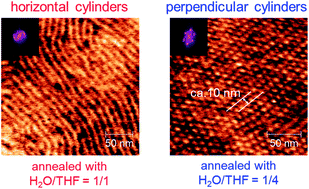In their recent Nanoscale Communication, Borsali et al. varied the composition of the annealing co-solvent in order to control the orientation of nanocylinders in sugar-based block copolymer thin films. Their method, which achieves nanopatterning in three dimensions, could have important applications in next-generation nanoelectronics.
The group have developed a novel class of natural-synthetic “hybrid” block copolymer, where one of the blocks consists of poly- or oligosaccharides. The rod-like structures formed by the saccharide blocks further sterically increase the incompatibility of the hydrophobicity-hydrophilicity imbalance of the saccharide and synthetic polymer blocks. The authors used H2O -THF mixtures as the annealing solvent system, since the saccharide component of the polymer is soluble in H2O, but not in THF, and vice versa for the other block polymer component. By changing the composition of the H2O-THF mixture, the orientation of the cylinder domain in the block copolymer thin film on a silicon substrate was successfully controlled from horizontal to perpendicular.
Read this HOT Nanoscale communication today:
Control of 10 nm scale cylinder orientation in self-organized sugar-based block copolymer thin films
Issei Otsuka, Salomé Tallegas, Yoko Sakai, Cyrille Rochas, Sami Halila, Sébastien Fort, Ahmad Bsiesy, Thierry Baron and Redouane Borsali
DOI: 10.1039/C3NR00332A











